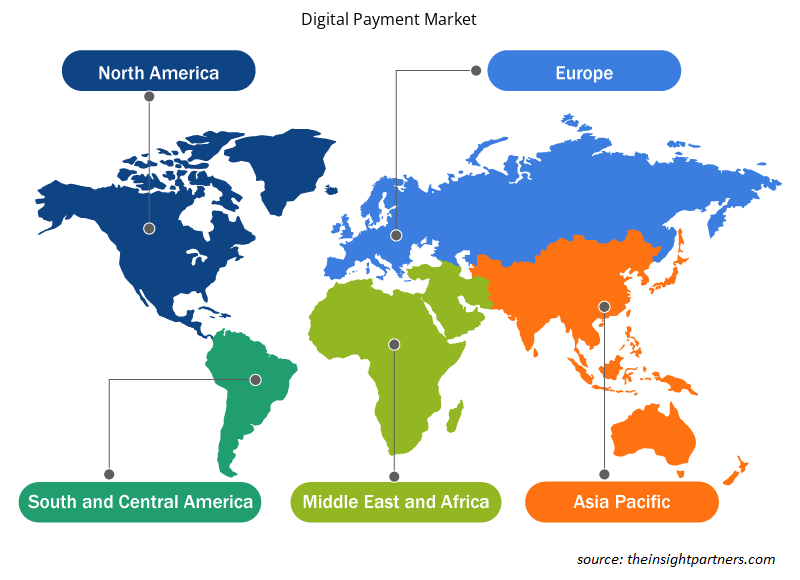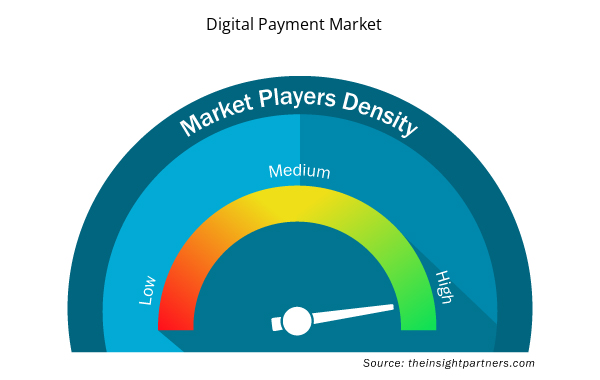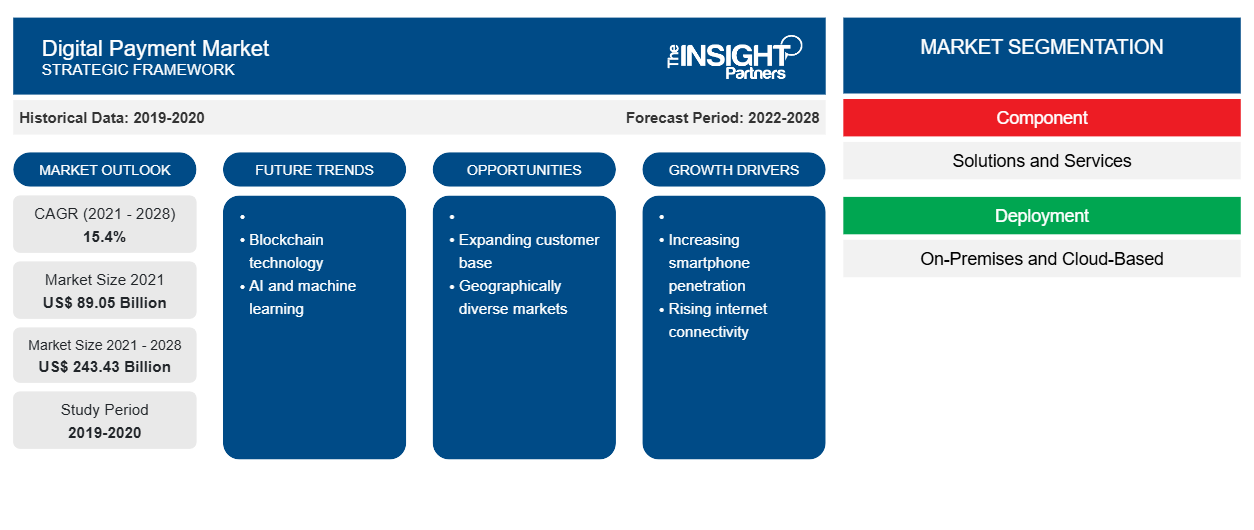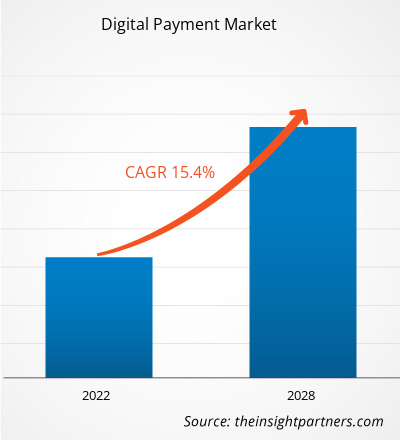デジタル決済市場は、2021年の890億4,567万米ドルから2028年には2,434億2,671万米ドルに成長すると予想されており、2021年から2028年にかけて15.4%のCAGRで成長すると予測されています。
スマートフォンの普及によりmコマースが拡大し、予測期間中に世界のデジタル決済市場が成長すると予想されています。人々がインターネットにアクセスする方法は、モバイルコマースの成長に直接影響します。スマートフォンはより手頃な価格になり、多くの国で高速インターネットがもはやプレミアムインフラストラクチャではなくなったため、ユーザーはインターネットサーフィンにPCよりもスマートフォンを好みます。小売業者は、カタログの閲覧が容易でチェックアウトが簡単なショッピングアプリケーションを開発しています。顧客が本質的に携帯電話に縛られているという事実は、銀行や決済サービスプロバイダーも見逃していません。銀行は、モバイルデバイスの画面で取引を完了できる銀行アプリを提供しています。モバイルコマースは、特にキャッシュレス決済の受け入れに関して、実店舗ビジネスの仕組みも変えました。さらに、物理的な商取引とデジタル商取引の違いは解消され、チャネルはますます収束しています。COVID-19パンデミック中に非接触型決済が重視されたため、店舗での購入体験はオンラインの体験に大幅に近づきました。また、パンデミック以前から、非接触型決済はいくつかの地域ですでに定着していました。オンライン購入体験では、非接触型決済や生体認証が普及しています。非接触型カードは、最も一般的な非接触型決済です。一方、モバイル決済は、使いやすさと、小売決済方法としてのOEM(Original Equipment Manufacturer)決済ソリューションの人気の高まりにより、人気が高まっています。一部の国では、小売業者や政府が顧客に非接触型決済を増やすよう積極的に要請し、小売業者にこれを可能にするよう奨励しています。多くの銀行は、販売時点におけるタッチパッドや現金の必要性を減らすために、非接触型決済の限度額を引き上げています。これらすべての要因が、デジタル決済市場の成長を促進しています。
要件に合わせてレポートをカスタマイズする
このレポートの一部、国レベルの分析、Excelデータパックなど、あらゆるレポートを無料でカスタマイズできます。また、スタートアップや大学向けのお得なオファーや割引もご利用いただけます。
- このレポートの主要な市場動向を入手してください。この無料サンプルには、市場動向から見積もりや予測に至るまでのデータ分析が含まれます。
COVID-19パンデミックがデジタル決済市場に与える影響
COVID-19パンデミックは、デジタル決済市場に恩恵をもたらしました。企業は、パンデミックとリモートワーク環境の発展により、新たな課題に直面しています。パンデミックへの政策対応に関する世界銀行の調査によると、少なくとも58の発展途上国の政府が、COVID-19対策としてデジタル決済を採用しています。少なくとも36か国が、現金の引き出しに加えて、貯蓄や取引に使用できる完全に機能する口座で資金を受け取りました。金融包摂には、このような広範な機能が必要です。さらに、2020年のパンデミックの発生は、世界の市場運営に多くの課題をもたらしました。先進国の医療インフラは、COVID-19の症例数の増加により崩壊しました。その結果、公衆衛生の緊急事態により、政府と市場関係者は、予測期間中に損失を回復するための研究開発イニシアチブの共同作業を通じて、市場運営と収益の回復に介入し、支援する必要があります。さらに、投資の増加は、今後数年間のデジタル決済市場にとって良い前兆です。
デジタル決済市場の洞察
オープンバンキングAPIの採用拡大
金融サービス企業は、オープンバンキングの取り組みとアプリケーションプログラミングインターフェースの重要性を認識しています。従来の銀行は、この分野で競争し、優れたオファーやサービスを提供する新規参入者に排除されないようにするために、デジタル機能を向上させる必要があることを理解しています。たとえば、PayPal、Wells Fargo、Visaなどの多くの金融サービス企業がオープンバンキングプロジェクトをサポートしています。また、ヨーロッパでは、2018年に発効した改訂版決済サービス指令(PSD2)に基づき、銀行はAPIを介して口座情報にアクセスできるようにすることが法的に義務付けられているため、オープンバンキングの取り組みは徐々に標準になりつつあります。オープンバンキングAPIは銀行の魅力を高め、銀行が既存の顧客の変化する期待に応え、新しい顧客を引き付けることを可能にします。APIは、安全で機敏で将来を見据えた方法で顧客とのやり取りを促進し、消費者の要件に応えるための独自のソリューションとして使用することもできます。オープンバンキングAPIは金融サービス組織にとって重要な資産です。サービス提供の拡大、顧客とのやり取りの促進、新しいデジタル収入チャネルの創出が可能になるため、予測期間中にデジタル決済市場が拡大する大きな機会がもたらされます。
導入セグメントの洞察
導入に基づいて、デジタル決済市場はオンプレミスとクラウドベースに分かれています。2020年にはクラウドベースのセグメントが市場をリードしました。クラウドベースの導入では、組み込みのデータセキュリティ、オンデマンドのスケーラビリティ、集中的なコンピューティングアクティビティを迅速に実行する能力が提供されます。クラウドは、デジタルウォレットの重要な実現要因です。デジタルウォレットが普及するにつれて、これらの利点により既存の機能が大幅に改善され、新しいイノベーションにつながる可能性もあります。リモート仮想ストレージを使用すると、物理サーバーが不要になり、停止や災害のリスクが軽減されます。クラウドは、強力なサイバーセキュリティ保護も提供し、金融サービス業界で特に関連するPCI DSS(Payment Card Industry Data Security Standard)などの重要な規制基準を満たすことができます。
組織規模セグメントの分析
組織の規模に基づいて、デジタル決済市場は大企業と中小企業に分かれています。大企業セグメントは2020年に市場をリードし、予測期間中に市場を支配すると予想されています。決済システムに関しても、冗長性を削減するには技術の採用が重要です。ただし、大規模な組織では、万能のソリューションは機能しません。中央銀行デジタル通貨(CBDC)の出現と、従来の決済システムでの暗号通貨の広範な採用の増加により、今後数年間で多くの大企業がデジタル通貨をアプリに組み込むことを余儀なくされるでしょう。これらの企業は、主に支払い、価値の保存、および分散型金融(DeFi)アプリで提供される高利回りの投資を活用するためにデジタル通貨を使用します。たとえば、PayGは大企業向けにカスタマイズされた決済ソリューションを提供し、回収方法の改善を支援します。これにより、大企業は現金の流入と流出を追跡し、プロセスを導入することなく必要に応じて拡張できるため、デジタル決済市場の成長を促進しています。
コンポーネントタイプセグメントの分析
アプリケーションに基づいて、デジタル決済市場はソリューションとサービスに分かれています。ソリューションセグメントは2020年に市場をリードしました。銀行、プロセッサ、通信事業者、および商人は、デジタル決済システムを使用して、国際決済基準に準拠したデジタル決済をスムーズに行うことができます。ソリューションには、デジタルカードのライフサイクルを制御するプラットフォームが含まれています。登録プロセス全体、および資格情報のプロビジョニングとセキュリティ管理を監視します。発行者とサービスプロバイダーは、プラットフォームを使用して、独自のウォレットまたはサードパーティのウォレットでサービスを提供できるため、市場の成長を促進します。ソリューションセグメントのグローバルデジタル決済市場は、決済ゲートウェイ、決済処理、決済セキュリティと詐欺管理、その他に分類されています。
デジタル決済市場のプレーヤーは、競争するために高度なテクノロジーと機能を統合することにより、新製品のイノベーションと開発に重点を置いています。たとえば、2021年1月、Okayと世界的な決済テクノロジー企業であるFSS Technologies(Financial Software and Systems)は、消費者決済、特にモバイルでのトランザクション検証と認証に重点を置いた認証セキュリティを提供するための提携を発表しました。次世代の製品、テクノロジー、ソリューションの提供により、FSSはすでにヨーロッパでの商業的可能性を拡大しています。2020年5月、Fiserv、Inc.は、エンタープライズおよび中規模市場の請求者向けの請求書と明細書の安全なデジタル配信ソリューションのサプライヤーであるInlet、LLC(「Inlet」)を買収しました。決済セクターには、同社のデジタル請求書支払い戦略を推進するInletが含まれます。
デジタル決済市場の地域別洞察
予測期間を通じてデジタル決済市場に影響を与える地域的な傾向と要因は、Insight Partners のアナリストによって徹底的に説明されています。このセクションでは、北米、ヨーロッパ、アジア太平洋、中東およびアフリカ、南米および中米にわたるデジタル決済市場のセグメントと地理についても説明します。

- デジタル決済市場の地域別データを入手
デジタル決済市場レポートの範囲
| レポート属性 | 詳細 |
|---|---|
| 2021年の市場規模 | 890.5億米ドル |
| 2028年までの市場規模 | 2,434.3億米ドル |
| 世界のCAGR(2021年~2028年) | 15.4% |
| 履歴データ | 2019-2020 |
| 予測期間 | 2022-2028 |
| 対象セグメント | コンポーネント別
|
| 対象地域と国 | 北米
|
| 市場リーダーと主要企業プロフィール |
|
デジタル決済市場のプレーヤー密度:ビジネスダイナミクスへの影響を理解する
デジタル決済市場は、消費者の嗜好の変化、技術の進歩、製品の利点に対する認識の高まりなどの要因により、エンドユーザーの需要が高まり、急速に成長しています。需要が高まるにつれて、企業は提供内容を拡大し、消費者のニーズを満たすために革新を起こし、新たなトレンドを活用し、市場の成長をさらに促進しています。
市場プレーヤー密度とは、特定の市場または業界内で活動している企業または会社の分布を指します。これは、特定の市場スペースに、その市場規模または総市場価値に対してどれだけの競合相手 (市場プレーヤー) が存在するかを示します。
デジタル決済市場で事業を展開している主要企業は次のとおりです。
- ACIワールドワイド株式会社
- アディエン
- ファイナンシャルソフトウェア&システムズ株式会社
- ファイザーブ株式会社
- グローバルペイメント株式会社
免責事項:上記の企業は、特定の順序でランク付けされていません。

- デジタル決済市場のトップキープレーヤーの概要を入手
デジタル決済市場 – 企業プロファイル
- ACIワールドワイド株式会社
- アディエン
- ファイナンシャルソフトウェア&システムズ株式会社
- ファイサーブ株式会社
- グローバルペイメント株式会社
- ノヴァッティグループ株式会社
- PayPalホールディングス株式会社
- ペイセーフリミテッド
- ブロック株式会社
- ペイユー
- 過去2年間の分析、基準年、CAGRによる予測(7年間)
- PEST分析とSWOT分析
- 市場規模価値/数量 - 世界、地域、国
- 業界と競争環境
- Excel データセット



Report Coverage
Revenue forecast, Company Analysis, Industry landscape, Growth factors, and Trends

Segment Covered
This text is related
to segments covered.

Regional Scope
North America, Europe, Asia Pacific, Middle East & Africa, South & Central America

Country Scope
This text is related
to country scope.
よくある質問
Increasing Prevalence of Smartphones Enabling Expansion of mCommerce
Rising Adoption of Contactless Payments
Financial services companies are recognizing the importance of open banking initiatives and application programming interfaces. Traditional banks understand that they must improve their digital capabilities to compete in the sector and avoid being disintermediated by new entrants with superior offers and services. For instance, numerous financial services companies such as PayPal, Wells Fargo, and Visa are supporting Open Banking projects. Also, in Europe, Open Banking initiatives are progressively becoming the norm because banks are legally required to make account information accessible via APIs under the Revised Payment Services Directive (PSD2), effective from 2018.
Open Banking APIs boost a bank's attractiveness and enable it to meet the changing expectations of existing clients and attract new ones. The APIs may also be used as a one-of-a-kind solution to boost customer interaction and respond to consumer requirements in a safe, agile, and future-proof way. Open Banking APIs are significant assets for financial services organizations because they allow them to expand service offerings, boost client interaction, and create new digital income channels, which would offer a significant opportunity for the digital payment market to expand during the forecasted period.
The rising demand of the diverse demands of customers, retailers, banks, telecom providers, and gadget suppliers is the primary reason for emerging digital payment model's success. It enables them to go to various locations, such as concerts, trade exhibits, and food trucks, where they may receive money from clients. This is accomplished by properly implementing mPOS in the industry. Retailers may use mPOS and associated software systems to improve and enhance consumer interaction, resulting in higher conversion rates and sales. Mobile point-of-sale (mPOS) refers to specific integrated devices that may operate as electronic point-of-sale terminals, such as smartphones and tablets. Mobile POS deployments allow brick-and-mortar retailers to use pricing, product information, and inventory data, enabling for omnichannel engagement, which, in turn, is likely to gain momentum for the digital payment market during the forecasted period.
Key companies in the digital payment market include ACI Worldwide, Inc; Adyen; Financial Software & Systems Pvt. Ltd.; Fiserv, Inc.; Global Payments Inc.; Novatti Group Ltd; and Paypal Holdings, Inc.
The global digital payment market is bifurcated on basis of organization type as small and medium enterprises (SMEs), and large enterprises. The global digital market is dominated by large enterprises segment in 2020, which accounted for ~ 68.4%.
North America held the largest market share in year 2020, along with the notable revenue generation opportunities in Europe and APAC.
Trends and growth analysis reports related to Banking, Financial Services, and Insurance : READ MORE..
The List of companies - Digital Payment Market
- ACI WORLDWIDE, INC
- ADYEN
- FINANCIAL SOFTWARE & SYSTEMS PVT. LTD.
- FISERV, INC.
- GLOBAL PAYMENTS INC.
- NOVATTI GROUP LTD
- PAYPAL HOLDINGS, INC.
- PAYSAFE LIMITED
- BLOCK, INC.
- PAYU
The Insight Partners performs research in 4 major stages: Data Collection & Secondary Research, Primary Research, Data Analysis and Data Triangulation & Final Review.
- Data Collection and Secondary Research:
As a market research and consulting firm operating from a decade, we have published and advised several client across the globe. First step for any study will start with an assessment of currently available data and insights from existing reports. Further, historical and current market information is collected from Investor Presentations, Annual Reports, SEC Filings, etc., and other information related to company’s performance and market positioning are gathered from Paid Databases (Factiva, Hoovers, and Reuters) and various other publications available in public domain.
Several associations trade associates, technical forums, institutes, societies and organization are accessed to gain technical as well as market related insights through their publications such as research papers, blogs and press releases related to the studies are referred to get cues about the market. Further, white papers, journals, magazines, and other news articles published in last 3 years are scrutinized and analyzed to understand the current market trends.
- Primary Research:
The primarily interview analysis comprise of data obtained from industry participants interview and answers to survey questions gathered by in-house primary team.
For primary research, interviews are conducted with industry experts/CEOs/Marketing Managers/VPs/Subject Matter Experts from both demand and supply side to get a 360-degree view of the market. The primary team conducts several interviews based on the complexity of the markets to understand the various market trends and dynamics which makes research more credible and precise.
A typical research interview fulfils the following functions:
- Provides first-hand information on the market size, market trends, growth trends, competitive landscape, and outlook
- Validates and strengthens in-house secondary research findings
- Develops the analysis team’s expertise and market understanding
Primary research involves email interactions and telephone interviews for each market, category, segment, and sub-segment across geographies. The participants who typically take part in such a process include, but are not limited to:
- Industry participants: VPs, business development managers, market intelligence managers and national sales managers
- Outside experts: Valuation experts, research analysts and key opinion leaders specializing in the electronics and semiconductor industry.
Below is the breakup of our primary respondents by company, designation, and region:

Once we receive the confirmation from primary research sources or primary respondents, we finalize the base year market estimation and forecast the data as per the macroeconomic and microeconomic factors assessed during data collection.
- Data Analysis:
Once data is validated through both secondary as well as primary respondents, we finalize the market estimations by hypothesis formulation and factor analysis at regional and country level.
- Macro-Economic Factor Analysis:
We analyse macroeconomic indicators such the gross domestic product (GDP), increase in the demand for goods and services across industries, technological advancement, regional economic growth, governmental policies, the influence of COVID-19, PEST analysis, and other aspects. This analysis aids in setting benchmarks for various nations/regions and approximating market splits. Additionally, the general trend of the aforementioned components aid in determining the market's development possibilities.
- Country Level Data:
Various factors that are especially aligned to the country are taken into account to determine the market size for a certain area and country, including the presence of vendors, such as headquarters and offices, the country's GDP, demand patterns, and industry growth. To comprehend the market dynamics for the nation, a number of growth variables, inhibitors, application areas, and current market trends are researched. The aforementioned elements aid in determining the country's overall market's growth potential.
- Company Profile:
The “Table of Contents” is formulated by listing and analyzing more than 25 - 30 companies operating in the market ecosystem across geographies. However, we profile only 10 companies as a standard practice in our syndicate reports. These 10 companies comprise leading, emerging, and regional players. Nonetheless, our analysis is not restricted to the 10 listed companies, we also analyze other companies present in the market to develop a holistic view and understand the prevailing trends. The “Company Profiles” section in the report covers key facts, business description, products & services, financial information, SWOT analysis, and key developments. The financial information presented is extracted from the annual reports and official documents of the publicly listed companies. Upon collecting the information for the sections of respective companies, we verify them via various primary sources and then compile the data in respective company profiles. The company level information helps us in deriving the base number as well as in forecasting the market size.
- Developing Base Number:
Aggregation of sales statistics (2020-2022) and macro-economic factor, and other secondary and primary research insights are utilized to arrive at base number and related market shares for 2022. The data gaps are identified in this step and relevant market data is analyzed, collected from paid primary interviews or databases. On finalizing the base year market size, forecasts are developed on the basis of macro-economic, industry and market growth factors and company level analysis.
- Data Triangulation and Final Review:
The market findings and base year market size calculations are validated from supply as well as demand side. Demand side validations are based on macro-economic factor analysis and benchmarks for respective regions and countries. In case of supply side validations, revenues of major companies are estimated (in case not available) based on industry benchmark, approximate number of employees, product portfolio, and primary interviews revenues are gathered. Further revenue from target product/service segment is assessed to avoid overshooting of market statistics. In case of heavy deviations between supply and demand side values, all thes steps are repeated to achieve synchronization.
We follow an iterative model, wherein we share our research findings with Subject Matter Experts (SME’s) and Key Opinion Leaders (KOLs) until consensus view of the market is not formulated – this model negates any drastic deviation in the opinions of experts. Only validated and universally acceptable research findings are quoted in our reports.
We have important check points that we use to validate our research findings – which we call – data triangulation, where we validate the information, we generate from secondary sources with primary interviews and then we re-validate with our internal data bases and Subject matter experts. This comprehensive model enables us to deliver high quality, reliable data in shortest possible time.


 このレポートの無料サンプルを入手する
このレポートの無料サンプルを入手する